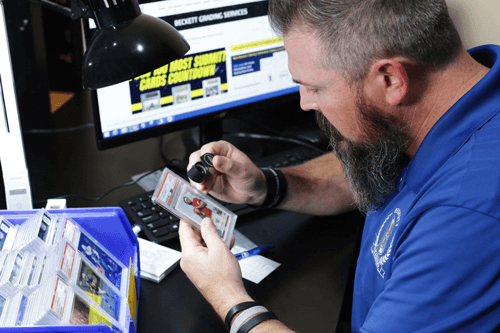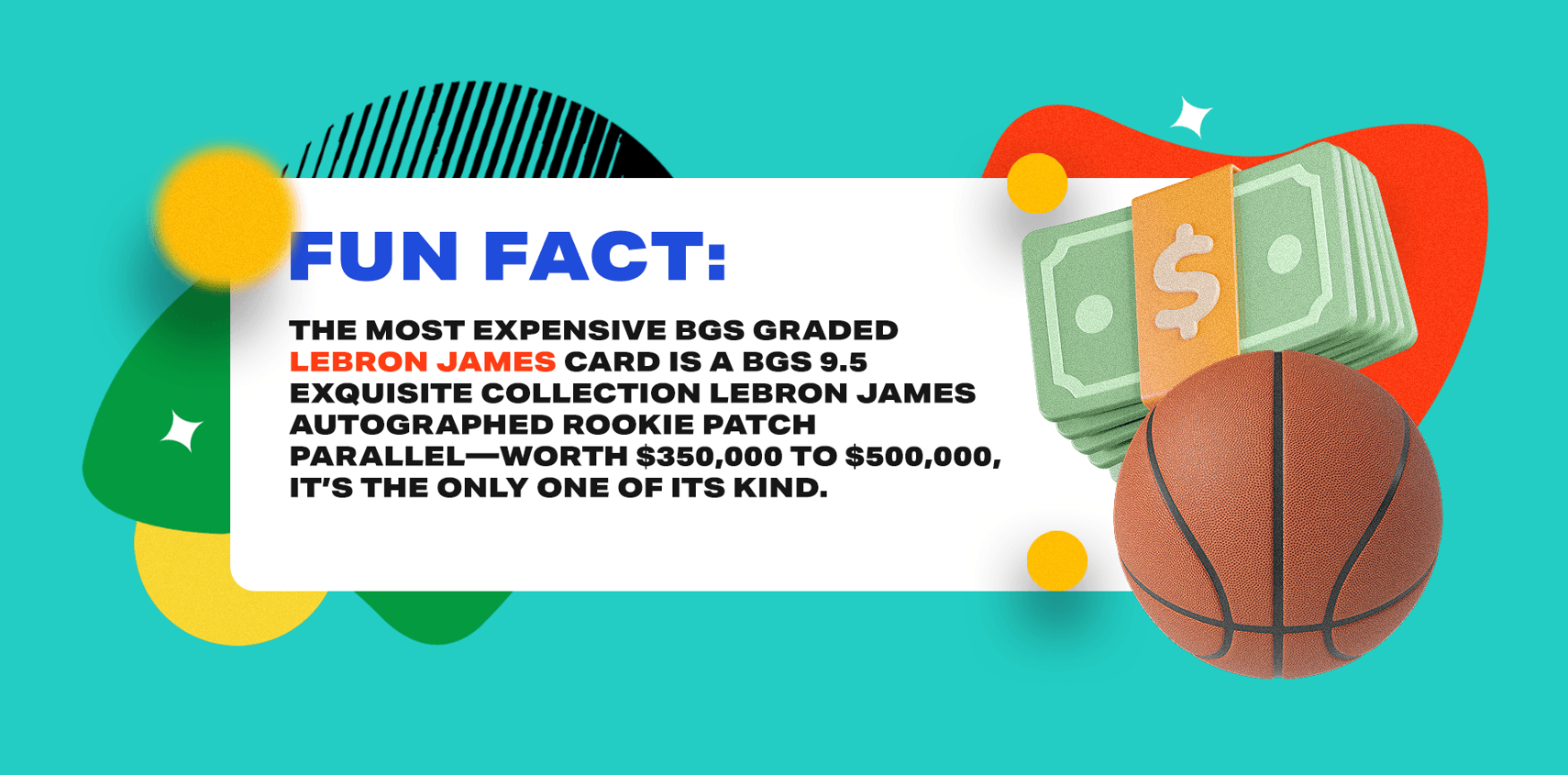The Beckett Sports Card Grading System Explained
Beckett Grading System is the premier sports card grading stale and has secured the title for ‘Best Grading Service’ six years in a row. Ensure your investment cards are top-notch with a Beckett grading.

For collectors, using a card grading system to verify the value of a trading card is similar to checking with a jeweler to know the quality of a watch or gem. It’s a critical step to secure investments, detect counterfeits, and anticipate high returns.
The Beckett Grading System card a row by readers of Card Trade, thanks to its commitment to integrity and expertise making it a reliable way for investors to make sure they’re getting the best cards for their collections.
The Beckett Grading System (BGS) is one of the many services collectors use to ascertain the value of their cards. It might also be one of the oldest card grading systems. Still, it’s a reliable way for investors to make sure they’re getting the best cards for their collections—and potentially make more money when they sell.
Beckett Grading’s commitment to integrity and expertise got it voted the ‘Best Grading Service’ in the world for six years in a row by readers of Card Trade—a literal stamp of legitness. It also is the largest and most popular sports card grading division in the industry due to its objective grading system and a BGS grading tends to boost card value.
What is the Beckett Grading System?
Beckett Grading Services (BGS) is a renowned third-party grading provider specializing in sports cards, gaming cards, and memorabilia, with a strong foothold in the post-1980s autograph market. As collectors increasingly acknowledge the advantages of professional grading, BGS accurate and consistent evaluations have become highly valued in the collectibles sector.
Initially a magazine publisher in 1984, Beckett expanded into sports card grading in 1991 and now boasts a respected reputation among collectors, dealers, and investors. Their offerings extend beyond grading, providing essential pricing details, news, and analysis for the collector community.
BGS employs a 1 to 10 point scale, incorporating half-points and subgrades for precise grading based on card centering, corners, edges, and surfaces. Cards are then enclosed in a secure, tamper-proof holder featuring a labeled BGS grade, ensuring optimal protection.

Sports cards graded using the Beckett Grading System (BGS).
Source: beckett.com
For investors, BGS grading delivers an impartial, trustworthy assessment of card conditions, supporting informed buying and selling decisions. Grading fees—starting at $100 without subgrades or $150 with subgrades—depend on submission quantities and preferred turnaround times.
BGS’s on-time guarantee provides added assurance, refunding fees if grading isn’t completed within the specified timeframe. Beckett Grading Services offers a reliable, yet slightly expensive, method for investors to ensure their collections contain top-quality cards.
Difference between PSA and BGS card grading?
BGS and PSA (Professional Sports Authenticator) are two of the most well-known grading companies when it comes to trading cards and collectibles, but they have some key differences.
In terms of grading trading cards, Beckett Grading Services and Professional Sports Authenticator offer two different, albeit similarly structured, services. PSA uses a point-based system that assigns grades from 1 which is ‘Poor‘ or 10 which is ‘Gem Mint.‘ On the other hand, BGS utilizes a more subjective approach and grades cards on a 10-point scale that includes 9.5 grades which they call ‘Gem Mint’.
For those who want their cards to look sharp and pristine, PSA’s grading system breaks down their grades into points, while BGS has a more subjective system and their labels come in different colors to represent the grades they assign.
BGS also includes subgrades for categories like centering and corner wear, allowing for a more detailed evaluation of the card.

A BGS grader examining a sports card.
Source: beckett.com
If you’re looking for a faster turnaround time and lower fees, BGS might be the way to go since their wait times and fees are both lower than those of PSA. While PSA has a larger community of collectors and dealers who trust their grading services, BGS has more high-quality slabs and cards with a UV-protection and a penny sleeve for added protection.
Desired turnaround time, budget, and the grades you expect for your cards are just some things to consider when deciding on a grading service—whether you prefer your cards graded by points or looks. In the end, BGS and PSA have different strengths and weaknesses, making it all come down to your preference and what works best for you and your collection.
How does Beckett Grading Service work?
When customers send in their cards, BGS logs and matches up the cards, and places them in a bin. Next, the invoicing department calculates the order, sets the guaranteed turnaround time, and processes the payment.
Once the cards are all accounted for, the verification department identifies each card and produces a unique sticker with a unique submission number, a unique serial number, a barcode, a due date, and a place for graders to assign grades.

Once the cards are identified, the graders get to work. They use a 1 to 10 scale that includes half pints to assign a numerical grade to each of the four subgrade categories: centering, corners, edges, and surface. If the card is deemed to be altered, BGS can either send it back to the customer with a note or encapsulate it and label it as ‘Authentic-Altered.’
Once the grading process is complete, the cards are enclosed in a BGS holder and placed in a bag to protect against scratching. The shipping department checks each card before securely packing them and the customer will receive tracking information and a link to the final grades. The BGS labels on a cards holder show its numerical grade that classifies it under each of the four subgrade categories:
Four categories of BGS:
- Centering: The assessment of centering is essential when considering the value of sports cards. A 10 grade will only be given if the card is virtually perfectly centered. When a card grader evaluates centering, they divide the card into left/right and top/bottom sections and observe the amount that is off-centered. A card that has a 50/50 distribution (50% of the card on the left/right side and 50% on the top/bottom) is viewed as perfectly centered.
- Corners: Collectors of raw sports cards can extend the life of their collections through proper storage and, when applicable, professional grading services. But it’s important to note that even if a card appears to have perfect corners without frays, grading companies use precise magnification to scrutinize cards’ condition and will only assign a 10 grade if all corners are in pristine condition.
- Edges: The edges of sports cards may be prone to deterioration such as chipping, which can expose white borders on the card. For a card to receive a 10 on the BGS grading scale, the edges must be pristine and almost perfect when viewed under magnification.
- Surface: The condition of a card’s surface is an important factor for card graders to consider, as it can be easily damaged by wax stains, scratches, loss of gloss, and printing defects. Due to their delicate nature, sports cards are especially prone to surface damage.
BGS card grading assigns each card a grade from 1 to 10 for each of the four main categories. These individual grades are then added together to provide an overall grade of 1 to 10 with 1 being the worst and 10 being the best. Lower graded cards can affect the overall BGS grade and value of a card.
For example, if a card receives a grade of 8.5 for condition, 9.5 for centering, 8.5 for corners, 8.5 for edges, and 9.5 for surface, the card’s overall grade would be 8.8. A grade of 9 or higher is considered a Mint and is potentially the highest grades for that card and could be worth book value or higher.
A grade of 9.5 is Gem Mint—cards with such high grades are often coveted by collectors. The rarest grade is a Pristine 10, which can turn a $10 card into a valuable collector’s item worth thousands of dollars.
Pros & Cons of Beckett Grading Services
Pros
- BGS provides assurance that your items are authentic and in the condition described and can increase their value.
- The BGS online submission system makes it easy to submit items for grading and to keep track of progress.
- BGS offers strong protection for your items with its crystal-clear holders and archival material.
Cons
- BGS is a less established company with a smaller community of collectors and dealers who use it as their go-to grader compared to PSA.
- BGS labeling system is not uniform and has a different color label for each grade which some collectors find less visually appealing.
- BGS is considered by some collectors to have a more lenient grading system and only grades autographs as ‘real’ or ‘fake.’
Is grading sports cards worth it?
Many investors are getting their dollars’ worth when grading cards because third-party certification provides greater trust and transparency for buyers and sellers. However, sports card grading isn’t always a sure bet for investors since it doesn’t boost a card’s value.
It’s important to consider the card’s condition, availability, desirability, and liquidity before investing in grading. Unless you’re looking at vintage cards, there is a chance that your card will not increase in value.
Nevertheless, grading still has a good chance of increasing its value compared to the raw cards. Grading costs around $20 per card, not including the cost of shipping, but it’s often worthwhile due to the added security, protection from counterfeits, buyer assurance, and higher resale value. Plus, card grading companies like PSA, Beckett, and SGC will provide an encased holder for your graded card to keep it safe.

Before grading, assess the value of the card on eBay to verify that the asking price is worth the costs associated with grading. As most graders rely on the naked eye, assess if any magnification tools will be helpful in evaluating the card.
Ultimately, grading expenses should be considered a sunk cost and should only be done if it will increase the card value or make the sale of the card easier. In other words, you want to be sure the cards you submit to be graded will be worth more than the money you must pay for shipping and grading the cards.
Investors should also be conservative with grade estimations, and research population report, eBay prices, and auction sales from places like PWCC and Goldin before submitting their cards to make sure it’s worth it. So when it comes to consciously investing, submitting cards to be graded can potentially be a wise decision.
Still, it’s good to keep in mind that you might not get a return on investment from submitting your cards. So it’s only a good idea to submit your trading card if you think you’ll get back more than what you paid to have cards graded when you sell the investment.
